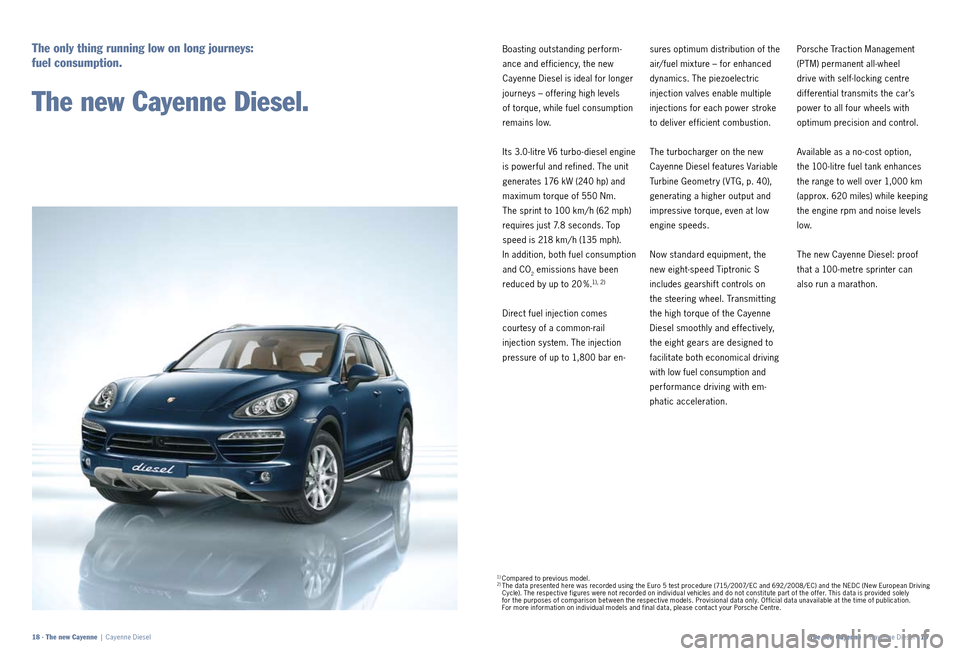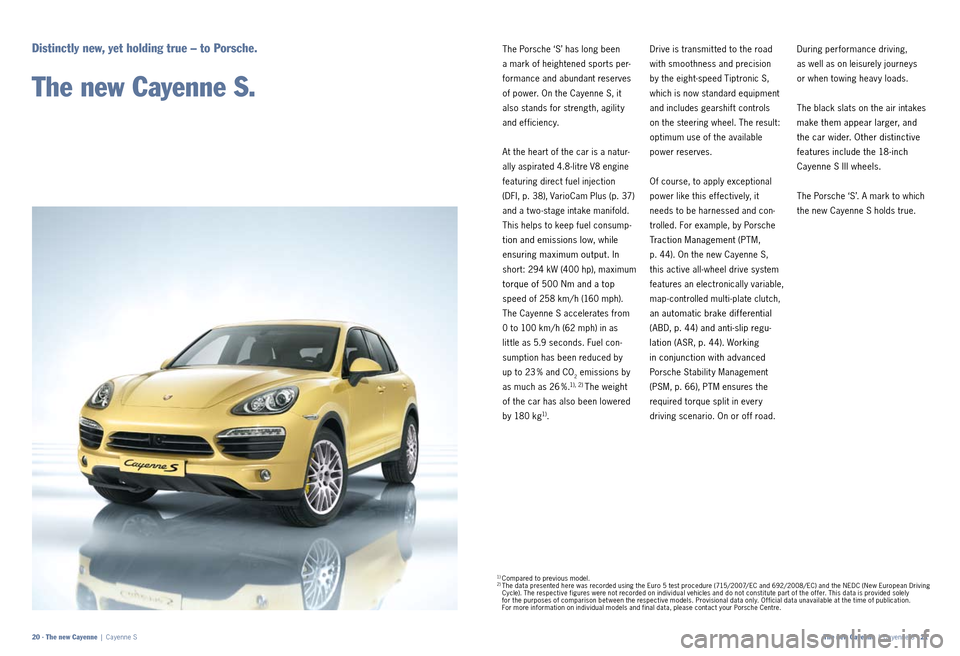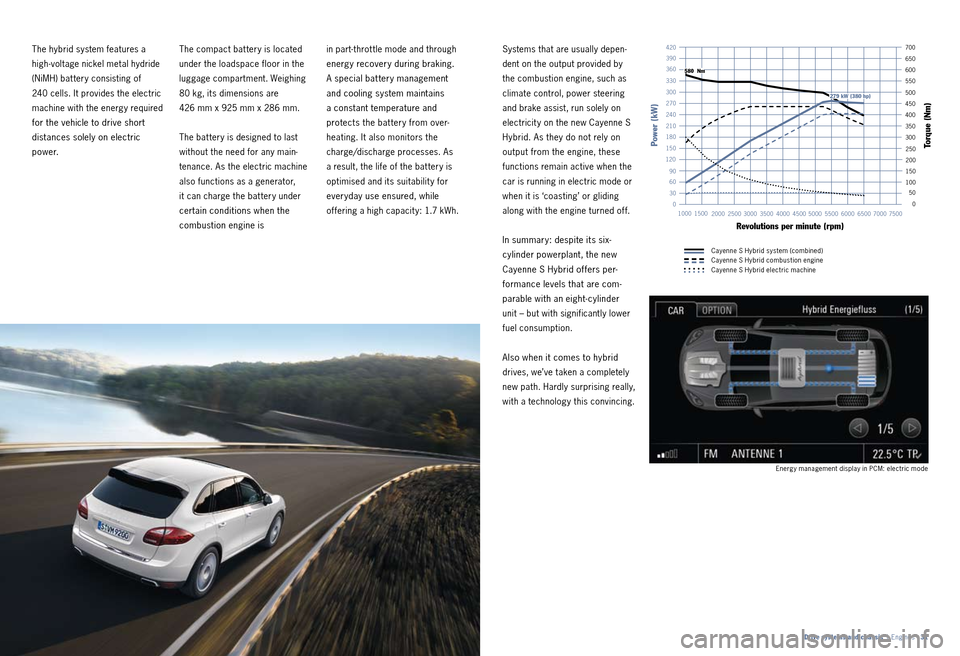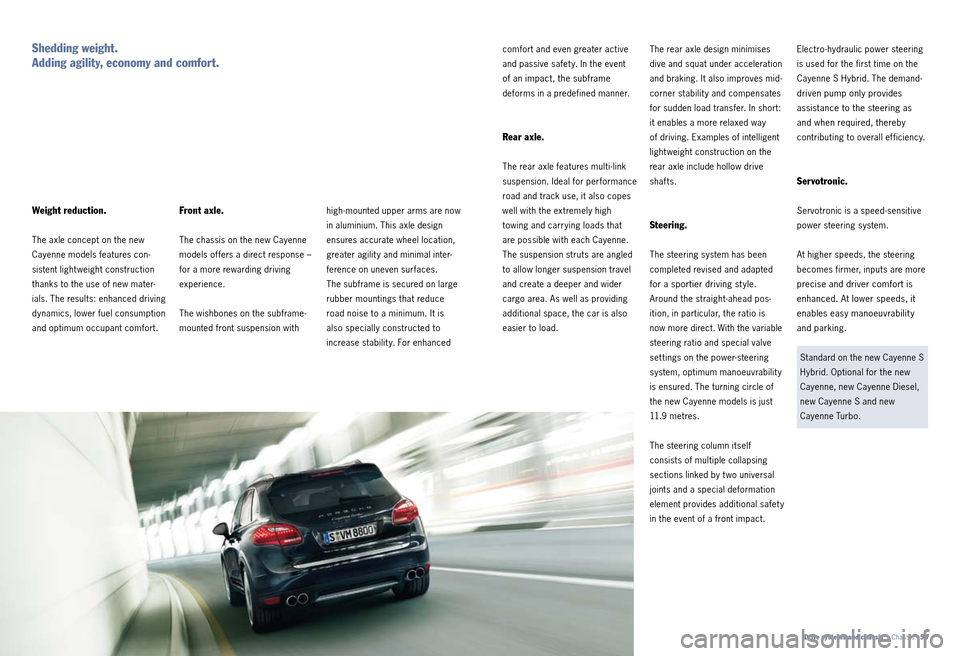power steering PORSCHE CAYNNE 2010 1.G Information Manual
[x] Cancel search | Manufacturer: PORSCHE, Model Year: 2010, Model line: CAYENNE, Model: PORSCHE CAYENNE 2010 1.GPages: 68, PDF Size: 4.52 MB
Page 7 of 68

Boasting outstanding perform
ance and ef ficiency, the new
Cayenne Diesel is ideal for longer
journeys – offering high levels
of torque, while fuel consumption
remains low.
Its 3.0 litre V6 turbo diesel engine
is powerful and refined. The unit
generates 176 kW (240 hp) and
maximum torque of 550 Nm.
The sprint to 100 km/ h (62 mph)
requires just 7.8 seconds. Top
speed is 218 km/ h (135 mph).
In addition, both fuel consumption
and CO
2 emissions have been
reduced by up to 20 %.
1), 2)
Direct fuel injection comes
courtesy of a common rail
injection system. The injection
pressure of up to 1,800 bar en sures optimum distribution of the
air/fuel mixture – for enhanced
dynamics. The piezoelectric
injection valves enable multiple
injections for each power stroke
to deliver efficient combustion.
The turbocharger on the new
Cayenne Diesel features Variable
Turbine Geometry (V TG, p. 40),
generating a higher output and
impressive torque, even at low
engine speeds.
Now standard equipment, the
new eight
speed Tiptronic S
includes gearshift controls on
the steering wheel. Transmit ting
the high torque of the Cayenne
Diesel smoothly and ef fectively,
the eight gears are designed to
facilitate both economical driving
with low fuel consumption and
performance driving with em
phatic acceleration. Porsche Traction Management
(PTM) permanent all
wheel
drive with self locking centre
dif ferential transmits the car’s
power to all four wheels with
optimum precision and control.
Available as a no cost option,
the 100 litre fuel tank enhances
the range to well over 1,000 km
(approx. 620 miles) while keeping
the engine rpm and noise levels
l o w.
The new Cayenne Diesel: proof
that a 100 metre sprinter can
also run a marathon.
The only thing running low on long journeys:
fuel consumption.
The new Cayenne Diesel.
1) Compared to previous model.2) The data presented here was recorded using the Euro 5 test procedure (715/2007/ EC and 692/2008/ EC) and the NEDC (New European Driving
Cycle). The respective figures were not recorded on individual vehicles and do not constitute part of the of fer. This data is provided solely
for the purposes of comparison bet ween the respective models. Provisional data only. Of ficial data unavailable at the time of publication.
For more information on individual models and final data, please contact your Porsche Centre.
The new Cayenne | Cayenne Diesel · 19
18 · The new Cayenne | Cayenne Diesel
Page 8 of 68

The Porsche ‘S’ has long been
a mark of heightened sports per
formance and abundant reserves
of power. On the Cayenne S, it
also stands for strength, agilit y
and efficiency.
At the heart of the car is a natur
ally aspirated 4.8 litre V8 engine
featuring direct fuel injection
(DFI, p. 38), VarioCam Plus (p. 37)
and a t wo stage intake manifold.
This helps to keep fuel consump
tion and emissions low, while
ensuring maximum output. In
short: 294 kW (400 hp), maximum
torque of 500 Nm and a top
speed of 258 km/ h (160 mph).
The Cayenne S accelerates from
0 to 100 km/ h (62 mph) in as
lit tle as 5.9 seconds. Fuel con
sumption has been reduced by
up to 23 % and CO
2 emissions by
as much as 26 %.
1), 2) The weight
of the car has also been lowered
by 180 kg
1). Drive is transmit ted to the road
with smoothness and precision
by the eight
speed Tiptronic S,
which is now standard equipment
and includes gearshif t controls
on the steering wheel. The result:
optimum use of the available
power reserves.
Of course, to apply exceptional
power like this ef fectively, it
needs to be harnessed and con
trolled. For example, by Porsche
Traction Management (PTM,
p. 44). On the new Cayenne S,
this active all wheel drive system
features an electronically variable,
map controlled multi plate clutch,
an automatic brake differential
(ABD, p. 44) and anti slip regu
lation (ASR, p. 44). Working
in conjunction with advanced
Porsche Stabilit y Management
(PSM, p. 66), PTM ensures the
required torque split in every
driving scenario. On or of f road. During performance driving,
as well as on leisurely journeys
or when towing heav y loads.
The black slats on the air intakes
make them appear larger, and
the car wider. Other distinctive
features include the 18 inch
Cayenne S III wheels.
The Porsche ‘S’. A mark to which
the new Cayenne S holds true.
Distinctly new, yet holding true – to Porsche.
The new Cayenne S.
1) Compared to previous model.2) The data presented here was recorded using the Euro 5 test procedure (715/2007/ EC and 692/2008/ EC) and the NEDC (New European Driving
Cycle). The respective figures were not recorded on individual vehicles and do not constitute part of the of fer. This data is provided solely
for the purposes of comparison bet ween the respective models. Provisional data only. Of ficial data unavailable at the time of publication.
For more information on individual models and final data, please contact your Porsche Centre.
The new Cayenne | Cayenne S · 21
20 · The new Cayenne | Cayenne S
Page 10 of 68

Understatement coupled with
clear statements: lower fuel
consumption, faster acceleration.
Supreme engineering that speaks
for itself. In short, every thing
you’d expect from a Turbo.
Another clear statement is the
distinctive sound from the t win
dualtube tailpipes. Produced by
the 4.8 litre t win turbo V8 engine
that delivers 368 kW (500 hp)
and features direct fuel injection
(DFI, p. 38). The car has a top
speed of 278 km/ h (173 mph)
and the benchmark sprint from
0 to 100 km/ h (62 mph) is com
pleted in 4.7 seconds. Maximum
torque is 700 Nm. Here too, fuel
consumption has been reduced
by
23 % and CO2 emissions by
2 5 % .
1), 2) Not least thanks to a
weight saving of 185 kg
1).
Optimum traction and safet y are
provided by Porsche Traction
Management (PTM, p. 44) active
all wheel drive. Also connecting
the car to the road are the new
19 inch Cayenne Turbo wheels. The chassis on the new Cayenne
Turbo is equipped as standard
with air suspension
featuring self
levelling and ride height control,
as well as Porsche Active Suspen
sion Management
(PASM, p. 51).
This electronic damping control
system offers continuous adjust
ment of the damping forces
on each wheel – depending on
current road conditions and
driving st yle.
This enables greater
car control, improving safet y and
comfort.
Comfort is also key in the new
Cayenne Turbo interior. Standard
equipment comprises an interior
package in smooth finish leather,
a rooflining in Alcantara and an
electrically adjustable steering
column.
Also fit ted as standard: the
BOSE® Surround Sound System,
Porsche Communication
Management (PCM) with navi
gation module, adaptive sports
seats with comfort memor y
package (18 way), Tyre Pressure Monitoring (TPM, p. 57), auto
matic headlight activation and
automatically dimming exterior
and interior mirrors.
Exterior features exclusive to
the new Cayenne Turbo include
Bi
Xenon headlights with Porsche
Dynamic Light System (PDLS,
p. 61), larger air intakes and a
distinctive ‘power dome’ on the
engine lid – a clear reference to
the enormous potential within.
Based on the same solid
foun
dations as its predecessor,
the new Cayenne Turbo blends
phenomenal performance with
comfort and ef ficiency. It does
so in st yle but without ever
compromising on any one in
particular. Because we believe
that less can also mean more.
Reduced weight, lower fuel consumption, fewer emissions.
At Porsche, we believe less is more.
The new Cayenne Turbo.
1) Compared to previous model.2) The data presented here was recorded using the Euro 5 test procedure (715/2007/ EC and 692/2008/ EC) and the NEDC (New European Driving
Cycle). The respective figures were not recorded on individual vehicles and do not constitute part of the of fer. This data is provided solely
for the purposes of comparison bet ween the respective models. Provisional data only. Of ficial data unavailable at the time of publication.
For more information on individual models and final data, please contact your Porsche Centre.
The new Cayenne | Cayenne Turbo · 25
24 · The new Cayenne | Cayenne Turbo
Page 13 of 68

in partthrot tle mode and through
energy recovery during braking.
A special bat tery management
and cooling system maintains
a constant temperature and
pro
tects the bat ter y from over
heating. It also monitors the
charge/discharge processes. As
a result, the life of the bat tery is
optimised and its suitabilit y for
everyday use ensured, while
offering a high capacit y: 1.7 kWh. Systems that are usually depen
dent on the output provided by
the combustion engine, such as
climate control, power steering
and brake assist, run solely on
electricit y on the new Cayenne S
Hybrid. As they do not rely on
output from the engine, these
functions remain active when the
car is running in electric mode or
when it is ‘coasting’ or gliding
along with the engine turned of f.
In summary: despite its six
cylinder powerplant, the new
Cayenne S Hybrid offers per
formance levels that are com
parable with an eight cylinder
unit – but with significantly lower
fuel consumption.
Also when it comes to hybrid
drives, we’ve taken a completely
new path. Hardly surprising really,
with a technology this convincing.
The compact bat tery is located
under the loadspace floor in the
luggage compartment. Weighing
80 kg, its dimensions are
426 mm x 925 mm x 286 mm.
The bat tery is designed to last
without the need for any main
tenance. As the electric machine
also functions as a generator,
it can charge the bat tery under
certain conditions when the
combustion engine is
The hybrid system features a
high
voltage nickel metal hydride
(NiMH) bat tery consisting of
240 cells. It provides the electric
machine with the energy required
for the vehicle to drive short
distances solely on electric
power.
Drive systems and chassis | Engines · 31
Energy management display in PCM: electric mode
100
50
0
300 350
400
450
500 550 600
650
0
30 60 90
120
150 180 210 240 270
300
330
150 200
250
Power (kW)
Torque (Nm)
1500
7500
2000 2500 3000 3500 4000 4500 5000 5500 6000 6500 7000
1000
Revolutions per minute (rpm)
360 390 420
700 580 Nm
279 kW (380 hp)
Cayenne S Hybrid system (combined)
Cayenne S Hybrid combustion engine
Cayenne S Hybrid electric machine
Page 25 of 68

highmounted upper arms are now
in aluminium. This axle design
ensures accurate wheel location,
greater agilit y and minimal inter
ference on uneven surfaces.
The subframe is secured on large
rubber mountings that reduce
road noise to a minimum. It is
also specially constructed to
increase stabilit y. For enhanced comfort and even greater active
and passive safet y. In the event
of an impact, the subframe
deforms in a predefined manner.
Rear axle.
The rear axle features multi
link
suspension. Ideal for performance
road and track use, it also copes
well with the extremely high
towing and carrying loads that
are possible with each Cayenne.
The suspension struts are angled
to allow longer suspension travel
and create a deeper and wider
cargo area. As well as providing
additional space, the car is also
easier to load. The rear axle design minimises
dive and squat under acceleration
and braking. It also improves mid
corner stabilit y and compensates
for sudden load transfer. In short:
it enables a more relaxed way
of driving. Examples of intelligent
light weight construction on the
rear axle include hollow drive
shafts.
Steering.
The steering system has been
completed revised and adapted
for a sportier driving st yle.
Around the straight ahead pos
ition, in particular, the ratio is
now more direct. With the variable
steering ratio and special valve
set tings on the power steering
system, optimum manoeuvrabilit y
is ensured. The turning circle of
the new Cayenne models is just
11.9 metres.
The steering column itself
consists of multiple collapsing
sections linked by t wo universal
joints and a special deformation
element provides additional safet y
in the event of a front impact. Electro
hydraulic power steering
is used for the first time on the
Cayenne S Hybrid. The demand
driven pump only provides
assistance to the steering as
and when required, thereby
contributing to overall efficiency.
Servotronic.
Servotronic is a speed sensitive
power steering system.
At higher speeds, the steering
becomes firmer, inputs are more
precise and driver comfort is
enhanced. At lower speeds, it
enables easy manoeuvrability
and parking.
Standard on the new Cayenne S
Hybrid. Optional for the new
Cayenne, new Cayenne Diesel,
new Cayenne S and new
Cayenne Turbo.
Front axle.
The chassis on the new Cayenne
models of fers a direct response –
for a more rewarding driving
experience.
The wishbones on the subf rame
mounted front suspension with
Weight reduction.
The axle concept on the new
Cayenne models features con
sistent light weight construction
thanks to the use of new mater
ials. The results: enhanced driving
dynamics, lower fuel consumption
and optimum occupant comfort.
Shedding weight.
Adding agility, economy and comfort.
Drive systems and chassis | Chassis · 55
Page 63 of 68

Technical data
Technical data · 131
130 · Technical data
Cayenne Cayenne Diesel
Engine/electric motor
Cylinders 6 6
Displacement 3,598 cm
32,967 cm3
Max. power (DIN)
at rpm220 kW (300 hp)
6,300 176 kW (240 hp)
4,000–4,400
Max. torque
at rpm 400 Nm
3,000 550 Nm
2,000 –2,250
Compression ratio 11.7:1 16 . 8 :1
Max. power (electric motor)
at rpm –
–
Max. torque (electric motor)
at rpm –
–
Max. power (parallel full hybrid)
at rpm –
–
Max. torque (parallel full hybrid)
at rpm –
–
Transmission
Layout Porsche Traction Management (PTM):
active allwheel drive with elec
tronically variable, map controlled
multi plate clutch, automatic
brake dif ferential (ABD) and anti slip
regulation (ASR) Porsche Traction Management (PTM):
permanent all
wheel drive with self
locking centre dif ferential, automatic
brake dif ferential (ABD) and anti slip
regulation (ASR)
6 speed manual gearbox Standard –
8 speed Tiptronic S Optional Standard
Chassis
Front axle Extralarge format double wishbone
suspension, fully independent Extra
large format double wishbone
suspension, fully independent
Rear axle Multilink suspension,
fully independent Multi
link suspension,
fully independent
Steering Powerassisted, hydraulic Powerassisted, hydraulic
Cayenne S Cayenne S Hybrid Cayenne Turbo
8 6 8
4,806 cm
32,995 cm34,806 cm3
294 kW (400 hp)
6,500 245 kW (333 hp)
5,500 – 6,500 368 kW (500 hp)
6,000
500 Nm
3,500 440 Nm
3,000 –5,250 700 Nm
2,250 – 4,500
12.5:1 10. 5:1 10. 5:1
– 34 kW (47 hp)
> 1,15 0 –
– 300 Nm
< 1,15 0 –
– 279 kW (380 hp)
5,500 –
– 580 Nm
1,000 –
Porsche Traction Management (PTM):
active all wheel drive with elec
tronically variable, map controlled
multi plate clutch, automatic
brake dif ferential (ABD) and anti slip
regulation (ASR) Porsche Traction Management (PTM):
permanent all
wheel drive with self
locking centre dif ferential, automatic
brake dif ferential (ABD) and anti slip
regulation (ASR) Porsche Traction Management (PTM):
active all
wheel drive with elec
tronically variable, map controlled
multi plate clutch, automatic brake
dif ferential (ABD) and anti slip
regulation (ASR)
– – –
Standard Standard Standard
Extra large format double wishbone
suspension, fully independent Extra
large format double wishbone
suspension, fully independent Extra
large format double wishbone
suspension, fully independent
Multi link suspension,
fully independent Multi
link suspension,
fully independent Multi
link suspension,
fully independent
Power assisted, hydraulic Powerassisted, hydraulic Powerassisted, hydraulic
Provisional data only. Of ficial data unavailable at the time of publication. Some of the vehicles featured in this catalogue are fit ted with optional
equipment available at extra cost. All information in respect of features, design, per formance, dimensions, weight, fuel consumption and running
costs is correct at the time of publication. Porsche reser ves the right to alter specifications and other product information without prior notice.